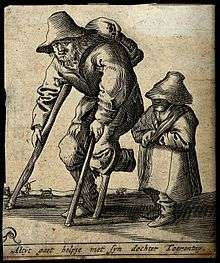Cripple
A cripple is a person or animal with a physical disability, particularly one who is unable to walk because of an injury or illness. The word was recorded as early as 950 AD, and derives from the Proto-Germanic krupilaz.[1] The German and Dutch words Krüppel and kreupel are cognates.
| Look up cripple in Wiktionary, the free dictionary. |

By the 1970s, the word generally came to be regarded as pejorative when used for people with disabilities.[2][3][4][5] Cripple is also a transitive verb, meaning "cause a disability or inability".
Cripples movement
In the same way that the term "queer" and the Nazi pink triangle has been reappropriated by the gay rights movement, members of the disability rights movement have reclaimed words such as "cripple", "crip", and "gimp" to refer to themselves.[5][6] The cripple tribunal in Dortmund on 13 December 1981 was one of the main protest actions of the autonomous German disability movement (in confrontation with the established disability assistance) against human rights abuses in nursing homes and psychiatric hospitals, as well as against deficiencies of local public transport. Analogous to the Russell Tribunal by Amnesty International, the cripple tribunal has denounced human rights violations of disabled people.[7]
Notable cripples in popular culture
- Philip Carey in W. Somerset Maugham's Of Human Bondage.
- "Tiny Tim" Cratchit (A Christmas Carol), a fictional character from Charles Dickens' novella A Christmas Carol (1843)
- Jaime Lannister, his captors amputated his dominant hand in A Song of Ice and Fire and its TV adaptation, Game of Thrones
- Bran Stark, Ned Starks' son, who lost the use of his legs when thrown out of a tower window, in A Song of Ice and Fire and its TV adaptation, Game of Thrones
- Joe Swanson, a paraplegic police officer and the Griffins’ neighbor in the animated show Family Guy.
Other usages
- Crips street gang were so named when members started carrying a cane which gave the impression they were crippled.[8]
- A cripple is a trimmer stud or joist which is shorter than full-length.[9]
- A cripple is a goods wagon or a passenger coach which although safe to run on the railway, is not fit for use and requires a repair before it can be used in service. This could be a coal wagon with a hole in the floor (which would allow coal to fall out of the wagon), or a passenger coach with a broken window.[10]
References
- Online Etymology Dictionary
- E. Eric John Miller; G. Geraldine V. Gwynne (1 January 1972). A Life Apart: A Pilot Study of Residential Institutions for the Physically Handicapped and the Young Chronic Sick. Taylor & Francis. pp. 41–. GGKEY:QCP9JKZ8RPE. Retrieved 14 July 2013.
- Barry Levy; Victor Sidel (25 August 2005). Social Injustice and Public Health. Oxford University Press. pp. 147–. ISBN 978-0-19-988375-2. Retrieved 14 July 2013.
- Reginald Nettles; Rochelle Balter (2011). Multiple Minority Identities: Applications for Practice, Research, and Training. Springer Publishing Company. pp. 3–. ISBN 978-0-8261-0703-9. Retrieved 14 July 2013.
- John Richardson; Justin Powell (17 May 2011). Comparing Special Education: Origins to Contemporary Paradoxes. Stanford University Press. pp. 264–. ISBN 978-0-8047-7913-5. Retrieved 14 July 2013.
- Susan Baglieri; Arthur H. Shapiro (2012). Disability Studies and the Inclusive Classroom: Critical Practices for Creating Least Restrictive Attitudes. Routledge. pp. 49–. ISBN 978-0-415-99372-2. Retrieved 14 July 2013.
- cripple tribunal on disabilityworld.org Archived 2010-11-23 at the Wayback Machine Retrieved 2012-01-21
- ""Crip" Gang Knowledge". www.corrections.com. Retrieved 20 May 2016.
- "Anatomy of a Stud-Framed Wall". FineHomeBuilding. 15 March 2001. Retrieved 20 May 2016.
- "Glossary and Terminology". www.railway-technical.com. Archived from the original on 7 October 2014. Retrieved 20 May 2016.